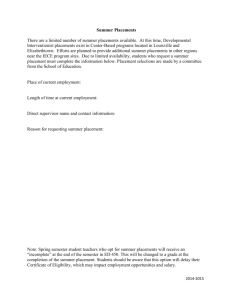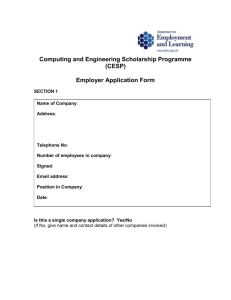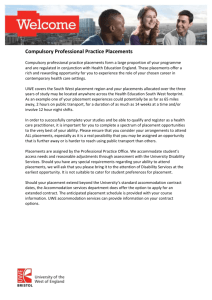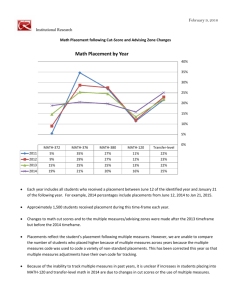Looked After Children and Complex Needs
advertisement
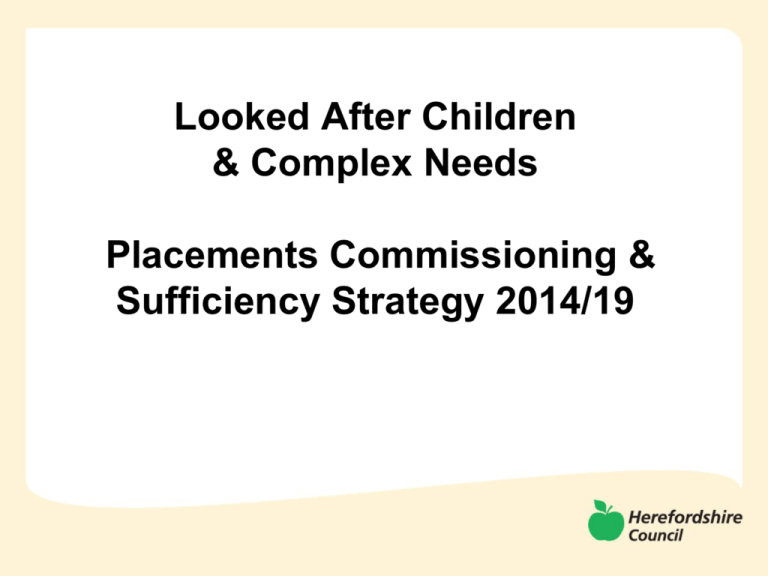
Looked After Children & Complex Needs Placements Commissioning & Sufficiency Strategy 2014/19 The Sufficiency Duty The Children Act requires local authorities to take steps that secure, so far as reasonably practicable, sufficient accommodation within the authority’s area which meets the needs of children that the local authority are looking after, and whose circumstances are such that it would be consistent with their welfare for them to be provided with accommodation that is in the local authority’s area In 2013/14 Herefordshire spent £8.6m on fostering, residential and complex needs accommodation placements 2011 Sufficiency Strategy Herefordshire’s first sufficiency strategy was implemented in 2011. It’s achievements include: • • • • • • • Despite a 31% increase (from 163 in 2011 to 213 in 2014) in the number of accommodation placements, spend on all in-house and agency accommodation rose by only 1% (from £8.5m in 2011/12 to £8.6m in 2013/14) A 38% increase of in-house fostering households from 88 in 2012 to 121 in2013 A framework agreement, in partnership with Worcestershire, for the purchase of fostering placements from independent agencies (IFAs) that avoided estimated costs of £540k over 2011/13 Improved use of independent fostering agencies rated as good or outstanding by Ofsted from, 73% in 2011 to 82%in 2014 Increased the Council’s in-house supported lodging scheme The re-procurement of supported accommodation and outreach support was completed, led by the Adult Wellbeing Directorate. This was reviewed in 2014 to strengthen the focus on support for looked after children Entered into a sub-regional framework agreement for supported accommodation for 16+ Strategic Needs Analysis A strategic needs analysis began in 2013 to inform Herefordshire’s sufficiency strategy beyond 2014. • Herefordshire’s LAC population is significantly higher than statistical neighbours, and is expected to rise further • A sufficiency strategy can help manage placement cost & quality • Overall cost management will depend on managing population growth and demand through early help and preventative work • In part, the Sufficiency Strategy seeks to reduce placement cost to reinvest resources in a whole system approach Strategic Needs Analysis • Around 200 children are normally fostered at any time, a quarter in IFA placements. The average annualised cost of a single IFA placement is £42,000 • LAC residential placements normally range 10-15 at any time. The average annualised cost of a single residential placement in £169,000 • There are normally around 20 complex needs placements at any time. The average annual cost of a single complex placement is £250,000 Strategic Needs Analysis The strategic needs analysis identified the following service gaps: 1. Over reliance on independent fostering agencies (IFAs), while Herefordshire paid around £800 per week for IFA placements, regional inhouse costs were £520. IFA spend in 2013/14 was £1.7m. In-house carer costs were £2m 2. Insufficient in-house ‘specialist’ foster carers and therapeutic support led to high-cost residential care that often didn’t deliver stability or positive outcomes for the child. LAC residential spend in 2013/14 was £1.4m 3. Insufficient local provision for children with complex needs led to over reliance on very high-cost residential care, often a great distance, causing institutionalisation and poor transitions to adulthood in some cases. Complex needs spend in 2013/14 was £3.5m 4. Slower than desired progress to commission a full range of services to meet the accommodation needs of young people aged 16+ because of a the lack of a robust needs analysis for this population 2014-19 Strategic Priorities 1. Reduce reliance on Independent Fostering Agency placements 2. Prevent use of residential placements by improving intensive wraparound support to children with challenging needs and their carers 3. Enable more children with complex needs to remain with their families or, if necessary, be accommodated closer to home 4. Improve the quality and availability of local supported living arrangements for Looked After Children aged 16+ 2014/19 Actions & progress 1. Reduce reliance on Independent Fostering Agencies A new IFA framework agreement has been commissioned with Worcestershire, which will avoid costs of £120k-£200k over the next 2-years. A new LAC Care Placements Strategy has been developed within the Directorate’s CHIPP transformation programme. Includes proposals to invest in the in-house fostering service for focussed carer recruitment, training and support Promotes more kinship fostering placements Deliver increased capacity and capability of in-house professional foster carers and supported lodgings hosts Target of moving from 75/25 to 90/10 split of in-house/IFA placements by 2019, which would reduce IFA spend by half 2014/19 Actions & progress 2. Prevent use of residential placements by improving intensive wrap-around support to children with challenging needs and their carers A new therapeutic intensive placement support services (known as HIPSS) has been commissioned from Action for Children using a proven evidence based model The service is expected to begin direct work with children in late 2014 The service will run in partnership with the in-house fostering service and provide 24/7 clinical therapeutic support to children placed with specialist in-house carers recruited via the new Care Placements Strategy Target of 50% reduction in LAC residential placements by 2019 2014/19 Actions & progress 3. Enable more children with complex needs to remain with their families or, if necessary, be accommodated closer to home More robust needs analysis work has begun for the complex needs population which will be used to inform future commissioning and service redesign proposals Work with schools, health and social care is idenifitying children at risk of entering the complex needs population in the coming years A small number of complex needs cases may be eligible for the HIPSS programme Existing complex needs cases are being reviewed to ensure placements are fit for purpose, opportunities to return to Herefordshire are maximised and transition to adult services is planned early A multiagency children with disabilities transformation strategy is being developed to redesign processes and services to work better together with families to prevent escalating need 2014/19 Actions & progress 4. Improve the quality and availability of local supported living arrangements for Looked After Children aged 16+ New Care Placements strategy includes proposals to invest in development of the in-house supported lodgings scheme More robust needs analysis of the 16+ LAC population has begun, including young people remanded to the care of the local authority Early discussions with housing about possible service models 2014/19 Intended outcomes Contribute to moving the authority to a ‘Good’ Ofsted rating by 2016/17. Based on a draft of the 2014/19 strategy, this year’s Ofsted inspection report noted that “the looked after children commissioning strategy is robust. It is based on trend analysis and an understanding of gaps in provision, and good team level knowledge of the young people known to children’s services. It is informed by best practice considerations, statutory requirements and case law.” Proportional shift in placement types achieves significant cost avoidance to that supports investment in the whole system approach of early help and preventative family support services A higher proportion of remaining placement spend remains within Herefordshire’s economy More children and young people benefit from experiencing life in a safe and table family environment, with improved transition to adulthood

